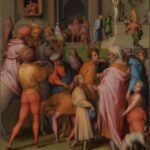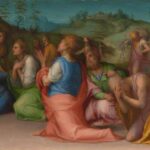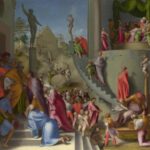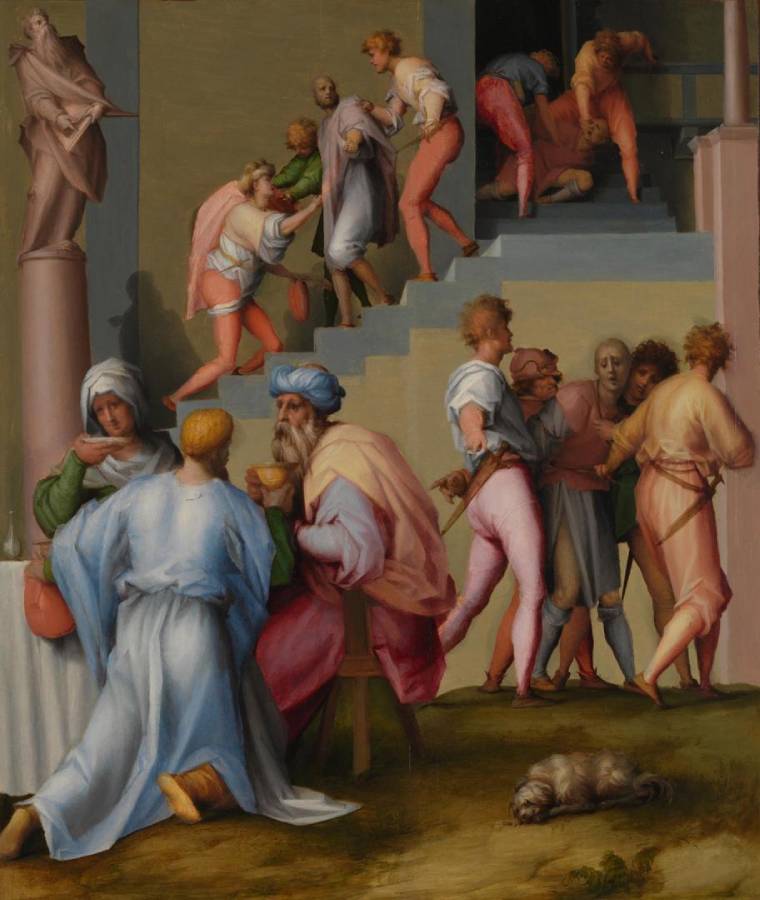Pontormo (1494-1557)
Supplizio del fornaio (Pharaoh with his Butler and Baker)
c.1515
Oil on wood, 61 x 51.7 cm
National Gallery, London
This is one of the panels that decorated the bedroom of Pierfrancesco Borgherini in the Borgherini palace in Florence. They tell the story of Joseph from the Old Testament and were probably originally set into furniture. The group of pictures by Florentine painters is known as The Story of Joseph: Scenes from the Borgherini Bedchamber and includes panels by Bacchiacca and Pontormo in the National Gallery’s collection. Granacci and Andrea del Sarto also contributed to the decorative scheme, which would have been one of the most sumptuous of the time.
This scene comes after Joseph sold to Potiphar. Joseph was his father’s favourite son with a coat of many colours, but he was sold into slavery by his jealous half-brothers and taken to Egypt. Bought by Potiphar, the head of Pharaoh’s guard, Joseph became overseer of Potiphar’s household. However, when he refused the sexual advances of Potiphar’s wife she falsely accused him of rape, and he was thrown into jail.
When in prison Joseph interpreted the dreams of Pharaoh’s butler and baker, who had been imprisoned for offending him. Joseph foresaw that the butler would be reinstated but the baker would be hanged. Here the baker is taken from prison (top right) and led to execution (right), while the butler is shown descending the staircase and serving Pharaoh (bottom left).
Like Joseph with Jacob in Egypt, the composition is structured on a staircase as a continuous narrative – with several scenes shown simultaneously. The setting is a strange unpaved space where Pharaoh, wearing a blue turban, is dining with a woman. A statue of an old man pointing to the open page of his book towers over them on a column at the foot of the staircase. He may be an Old Testament prophet but his identity is unclear. The indeterminate setting, limited depth and prominent staircase give the painting an unsettling feeling, which reflects Pontormo’s interest in the new Mannerist style – a reaction against the naturalism of the High Renaissance – which was becoming fashionable in Florence at the time.
Joseph had asked the butler to mention him to Pharaoh and secure his release, but the butler forgot. Joseph remained in prison for another two years until Pharaoh himself had a dream of seven fat cows and seven lean cows, which none of his advisers could interpret. The butler remembered Joseph, who advised Pharaoh to store grain because seven plentiful years would be followed by seven years of famine. The next part of the story is told in Joseph’s Brothers beg for Help. (NG)
Scenes from the Story of Joseph:
 Pontormo (1494-1557)
Pontormo (1494-1557)
Giuseppe venduto a Putifarre
c.1515
National Gallery, London
 Pontormo (1494-1557)
Pontormo (1494-1557)
I fratelli di Giuseppe chiedono aiuto
c.1515
National Gallery, London
 Pontormo (1494-1557)
Pontormo (1494-1557)
Giuseppe con Giacobbe in Egitto
probably 1518
National Gallery, London
